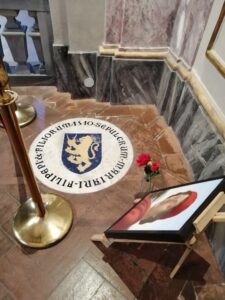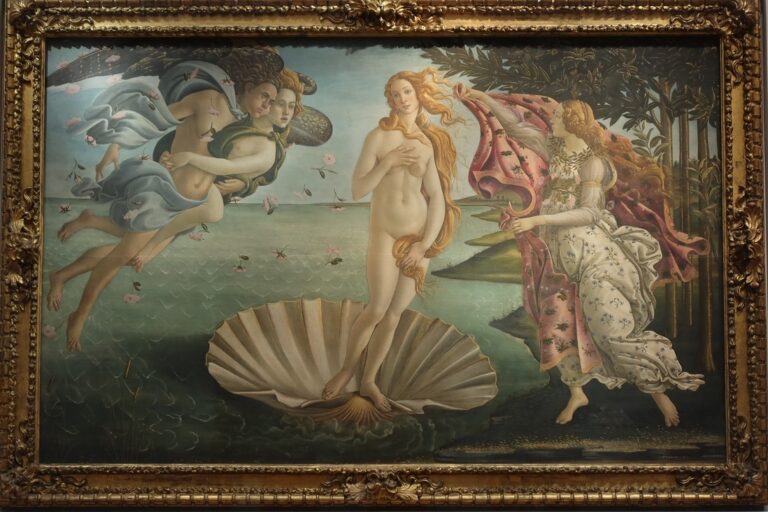Up close and personal with a classic of the Italian renaissance
—–
It was only as our night train from Vienna drew towards Florence that I remembered that the city is home to “The Birth of Venus” by Sandro Botticelli. Florence being synonymous with world-famous art, it was remarkably remiss of me not to have thought beforehand about what priceless masterpieces might be sitting around there ready to be gawped at. I’m tempted to blame the oversight on being perimenopausal.
In truth, I’d been completely lackadaisical and passive about the entire trip. It was all The Other Half’s idea, and I was happy to let myself be dragged along in the slipstream of his excellent planning. I’m usually the driving force behind art-themed trips, so I was pleasantly surprised when he suggested we go to see the British-Indian artist Anish Kapoor’s new exhibition “Unreal, Untrue” in Palazzo Strozzi. I was on board with the idea right away.
Last minute panic
So here we are, with just half an hour until the train arrives in Florence. And I’m having a manic “I want to see this! And this! And we HAVE to see THIS!” freak-out while struggling into my clothes in the tiny couchette, annoying the neighbours by banging my elbows against the partition wall.
The Other Half, a little peeved at my last-minute drama and demands, politely agrees to go straight to the Uffizi Gallery first thing. As always, there’s a plan and a schedule: we’ll arrive in Florence at about 6:30am. We’ll find a place to store the suitcase, walk across town to the river, get a coffee and then be at the gallery doors in time for opening at 8:30am.
Being January, we don’t have to fight through any crowds or waste time standing in mile-long queues. In fact, we’re the third in line to get tickets. A quick dump of the rucksacks later and we’re heading upstairs to find the start of the permanent exhibition.
Making a beeline for Botticelli
As usual, I stroll straight through the sections with the religious art of the Middle Ages. It’s not that I don’t appreciate its value. It’s just that I’ve seen quite a lot of it already and I’m not a fan. I don’t go in for the 2D figures, the vacant facial expressions, or the weird baby Jesuses who look like middle-aged men who’ve shrunk in the washing machine. And I especially don’t like the way that medieval artists seemed to think that women’s breasts are a) more or less spherical, and b) sprout out of the base of their necks. Bit further south, fellas…
Forget that. I’m making a beeline for the work of a painter who revolutionised the idea of what painting could be in the Florence of the 1400s. Sandro Botticelli.
Alone with a renaissance classic
I know immediately that I’m in the presence of the great master when I enter the room. The faces of Botticelli’s women have a signature elongated serenity to them that no other painter has ever echoed or equalled. I take a minute or two to admire a fresco showing the annunciation and the well-known “Primavera” – but I’m just a few steps away from the most famous Botticelli woman of all, and I can’t wait to meet her…
Turning right, I’m suddenly faced with one of the world’s most instantly recognisable images. The picture that launched a billion tote bags, fridge magnets and assorted other tourist tat. The Birth of Venus.
And now, I’m all alone with her. For a precious few minutes, I have this landmark piece of Italian renaissance art all to myself. What a privilege.
How quiet it is – I can almost hear the wind rustling through the leaves of the trees in the picture and the fabric of the robes flapping in the breeze. Floating gently towards me on the waves, Venus looks like she could step down off that scallop shell and right into the room with me.
And what do I think as I gaze upon this sublime vision of alabaster womanhood? Am I thinking highbrow intellectual thoughts about the maybe-Christian-maybe-pagan symbolism of the scallop shell? Or about the significance of Venus’s posture? Or why this painting might have been commissioned all those centuries ago?
No, I am not. At this seminal moment of my art-gazing career, I am not thinking anything remotely intelligent or incisive. Once the sensuality overload of the first glance subsides, all I am thinking is “Oh my God! I’m looking at The Birth of Venus! The actual one! I can’t believe it!”
The Birth of Venus – the serious bit
Once I’ve got a hold of myself, I try to recall what I learned about the painting from James Payne’s excellent “Great Art Explained” series on YouTube (which I’ve been watching religiously for months).
The Birth of Venus was unveiled in Florence in 1485. At that time, it was one of the biggest, richest cities in Europe, having risen to power through a combination of European trade and banking. The Medici family were the de facto rulers of the city and were patrons of some of the most important artists of the time, including Leonardo da Vinci, Michaelangelo and Botticelli.
It was at this time that new ideas had begun to gestate and spread across Europe. The rise of humanism moved the focus in art and culture away from religion and towards the achievement and value of the individual. At the same time, neoplatonism pushed artists to portray such perfect forms of beauty as could only exist beyond their own imperfect world. In painting, this manifested itself in new forms of perspective and in the depiction of secular, mythological figures showing natural, human emotions. Botticelli’s Primavera and Birth of Venus are among the best examples of this.
Lorenzo de Medici, who is thought to have commissioned the Birth of Venus, was known to have humanist views and financially supported both the humanist and neo-Platonic school of painting from which Botticelli’s most famous works are said to have originated.
Who are these people?
The name of the painting is a slight misnomer. It does not show Venus being born from the waves, but floating towards the island of Cyprus on her scallop shell after her birth. Two mythical figures to the left (thought to be Zephyr, the god of wind, and Cloris) blow Venus towards shore, where another figure (believed to be the Hora of spring) stands ready to clothe Venus in a flowing pink robe decorated with flowers.
Perhaps it is a little difficult for us to understand these days, but the Birth of Venus represented a revolution in its depiction of a full nude of a non-religious character. Venus’s modest pose was probably inspired by the Venus pudica style of sculpture which moved females away from being passive objects to independent figures. In fact, the alabaster of her skin – luminous and radiating beauty, youth and fertility – puts one in mind of smooth, flawless marble.
Yet, in contrast to the solidity and static of marble, the Birth of Venus is full of a movement that had never been seen in painting. While dispensing with the requirements of realism (none of the figures cast shadows, the Hora appears to float shoeless above the ground, and Venus is anatomically rather improbable), Botticelli manages to capture and hold our attention with the flowing lines of Venus’s long hair, the Hora’s billowing dress and robe, and the flying figures to the left. All is focused on the imminent arrival of this goddess of love and beauty at her destination. No wonder many critics believe that this painting could have been commissioned in celebration of a marriage – and thus of the arrival of a young woman into a family who may bear children and thus secure the future of a dynasty. At its heart, the Birth of Venus is a painting celebrating love and sex.
Fabulous – who could possibly object?
Botticelli’s fate
Possibly the artist himself.
There is a certain irony in the fact that Botticelli’s most famous works are the ones with secular motifs. He was in fact a deeply religious man; he may even have been a follower of the firebrand Dominican friar and preacher Girolama Savonarola, who railed against the modern ideas pushed by the Medici family. It’s not hard to imagine that the new ways of thinking sweeping through Florence might have come into conflict with Botticelli’s own worldview and that he created images like Venus and Primavera purely to stay in work and put food on the table.
Whatever the true nature of his relationship to Savonarola, Botticelli’s painting style undoubtedly began to shift back towards more classic, religious motifs around the time of Savonarola’s rise to prominence.
Botticelli’s bond to the Medici family weakened, as they began to favour other artists, possibly wishing to further pursue the ideas embodied by Botticelli’s most famous works. He fell on hard times and is said to have only been saved from starvation because old friends gave him financial support. He died in penury in 1510 and was buried with his family in the San Salvatore in Ognissanti church close to the shores of the Arno.
Although the grave has long since been built over, there is a marking on the floor to indicate the spot. Here, visitors may pay their respects to this mysterious yet iconic artist, whose best-known works may have been those furthest from his own heart.

—–
More from the Great Art Encounters series:
“Judith Slaying Holofernes” by Artemisia Gentileschi
“The Slav Epic” by Alphonse Mucha
